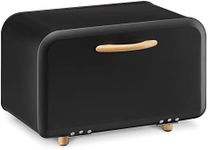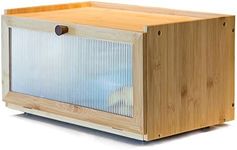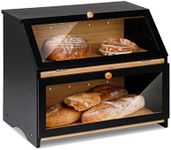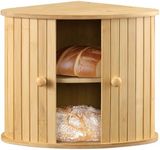Buying Guide for the Best Bread Boxes
Choosing the right bread box can help keep your bread fresh for longer, reduce waste, and add a touch of style to your kitchen. When shopping for a bread box, it's important to consider how much bread you typically store, the space available in your kitchen, and your personal style preferences. Understanding the key features will help you find a bread box that fits your needs and keeps your baked goods at their best.MaterialThe material of a bread box affects both its appearance and how well it preserves bread. Common materials include wood, metal, plastic, and ceramic. Wooden bread boxes often provide a classic look and allow for some air circulation, which helps prevent mold. Metal bread boxes are durable and can have a modern or retro style, but they may not insulate as well. Plastic bread boxes are lightweight and easy to clean, but may not be as sturdy. Ceramic bread boxes are attractive and good at maintaining a stable environment, but can be heavy and breakable. When choosing, think about your kitchen decor, how much you value durability, and whether you want something easy to clean or more decorative.
Size and CapacitySize and capacity determine how much bread or baked goods you can store at once. Bread boxes come in compact sizes for small households or larger sizes for families who go through a lot of bread. If you only keep one loaf at a time, a smaller box will save space. If you like to store multiple loaves, bagels, or pastries, look for a larger box. Measure your counter space before buying to ensure the bread box will fit comfortably without crowding your kitchen.
VentilationVentilation refers to how much air can flow in and out of the bread box. Good ventilation helps prevent mold by allowing moisture to escape, but too much airflow can dry out bread. Some bread boxes have small holes or slats for controlled ventilation. If you live in a humid area, a box with more ventilation can help keep bread from getting moldy. In drier climates, less ventilation will help keep bread from going stale too quickly. Consider your local climate and how quickly you eat bread when deciding how much ventilation you need.
Seal and ClosureThe seal and closure mechanism affects how well the bread box keeps out air, pests, and moisture. Some bread boxes have tight-fitting lids, while others use roll-top doors or simple lift-off covers. A tighter seal can help keep bread fresher, but may trap too much moisture if not ventilated. If you want easy access, look for a box with a smooth-opening mechanism. Think about how often you’ll be opening the box and whether you need extra protection from insects or pets.
Ease of CleaningEase of cleaning is important for hygiene and maintenance. Bread crumbs and moisture can build up inside, so a bread box that’s easy to wipe out or wash will save you time. Some materials, like plastic and metal, are easier to clean than wood or ceramic. Removable lids or wide openings also make cleaning simpler. If you want low-maintenance, look for a bread box with smooth surfaces and minimal crevices.
Design and StyleDesign and style are about how the bread box looks in your kitchen. Bread boxes come in many shapes, colors, and finishes, from vintage to modern. Some have decorative patterns, while others are sleek and simple. Choose a design that matches your kitchen decor and personal taste, since the bread box will likely sit on your countertop and be seen every day.














